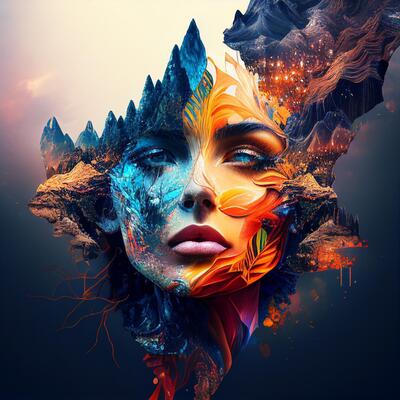Digging Into the Diverse World of Artistic Expression: From Surrealism to Abstract Realistic Look
In the world of artistic expression, from the dreamlike landscapes of surrealism to the detailed play of light and type in abstract realism, artists have actually continuously pressed the boundaries of creative thinking and creative imagination. Each motion holds an unique lens whereby the world is viewed and analyzed, offering a glance into the midsts of human feeling, understanding, and assumed. As we check out the complex globe of art, we exist with a tapestry of styles, strategies, and viewpoints that test our understanding and provoke consideration. The trip through these diverse forms of imaginative expression promises to unwind an abundant tapestry of visual narration and intellectual questions that captivates the mind and mixes the heart.
Surrealism: Unleashing the Subconscious
Surrealism, an avant-garde artistic motion of the 20th century, looked into the midsts of the subconscious, introducing a world of dream-like imagery and non-traditional associations. Spearheaded by musicians like Salvador Dali, René Magritte, and Joan Miró, Surrealism looked for to test the standard ways of seeing and understanding art. Through techniques such as automatism and desire analysis, Surrealist musicians aimed to tap into the subconscious mind to expose hidden truths and wishes.
Among the crucial elements of Surrealism was the focus on the illogical and the uncanny. By integrating unanticipated aspects in their works, Surrealist artists aimed to develop a sense of disorientation and shock in the viewer. This interruption of reasoning and factor was suggested to prompt a much deeper expedition of the subconscious and the enigmas of the human mind.
Abstract Realism: Redefining Understanding
Testing traditional creative boundaries, Abstract Realism redefines understanding via the combination of identifiable aspects with abstract forms. This innovative technique to art combines the representational accuracy of realism with the creative freedom of abstraction, offering audiences a distinct visual experience that prompts them to question their perception of reality.
In Abstract Realism, musicians make every effort to capture the significance of their topics while additionally infusing their collaborate with a sense of depth and intricacy with abstract components. By mixing the acquainted with the unfamiliar, these musicians invite audiences to involve with their pieces on several levels, motivating them to explore the subtleties of color, appearance, and type.

Cubism: Fragmentising Reality
Making use of geometric kinds and fragmented point of views, Cubism reinvented the artistic depiction of fact in the early 20th century. This technique not just deconstructed fact but also highlighted the monotony of the canvas, leading the way for future abstract art movements.

Cubism can be classified into 2 major phases: Analytical Cubism, identified by single color design and elaborate, fragmented kinds; and Artificial Cubism, which integrated collage aspects and brighter shades right into the structures. With these distinct stages, Cubism affected not only painting yet likewise design, architecture, and sculpture. trump art. Its impact reverberated across the art globe, motivating artists to check out new methods of interpreting and representing the world around them
Expressionism: Emotions on Canvas
Checking out the depths of human feelings via meaningful and dazzling brushstrokes, Expressionism emerged as an extensive imaginative motion in the early 20th century. Unlike previous art movements that concentrated on portraying the external globe, Expressionism dove into the inner realm of the artist's subconscious, intending to evoke raw emotions and provoke visceral responses from visitors.
Expressionist artists, such as Edvard visit this site Munch, Egon Schiele, and Emil Nolde, turned down typical ideas of beauty and realism in favor of misshaping kind and shade to convey subjective feelings. Making use of overstated brushwork, strong shades, and distorted figures aided develop a sense of unease, alienation, or interest in their jobs.
One of one of the most popular examples of Expressionism is Munch's "The Scream," which records the intense anxiety and anguish of contemporary life through its swirling, distorted figure versus a blood-red skies. Through their psychologically billed works, Expressionist artists looked for to test conventional artistic norms and give a window right into the stormy midsts of the human spirit.
Contemporary Art: Progressing Perspectives

One of the defining features of contemporary art is its constant advancement and capacity to adjust to altering social landscapes. Musicians are significantly incorporating technology right into their technique, obscuring the lines in between the digital and physical realms. This combination of mediums enables cutting-edge means of storytelling and involving with target markets in a much more interactive manner.
Moreover, contemporary art often acts as a system for social commentary, dealing with pressing issues such as identification, politics, and the setting. Artists are utilizing their work to spark vital discussions and provoke thought, dropping light on the intricacies of the world we reside in. As viewpoints remain to progress, modern art remains a prominent Related Site and dynamic force in forming our cultural landscape.
Conclusion
To conclude, the world of imaginative expression includes a vast array of activities and styles, each with its own one-of-a-kind strategy to conveying meaning and emotion. From surrealism's exploration of the subconscious to abstract realism's redefining of perception, and from cubism's fragmentation of fact to expressionism's representation of emotions, art continues to evolve and test point of views - trump art. Contemporary art shows the ever-changing world we stay in, providing brand-new ways to analyze and understand the complexities of our reality
As we discover the multifaceted globe of art, we are offered with a tapestry of styles, content techniques, and viewpoints that challenge our understanding and prompt consideration. Its impact reverberated across the art world, inspiring artists to check out new ways of analyzing and standing for the globe around them.
